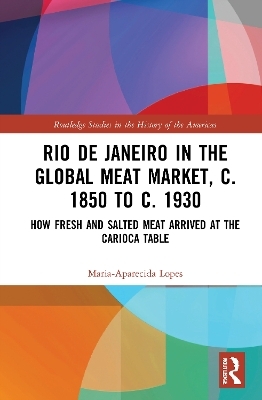
Rio de Janeiro in the Global Meat Market, c. 1850 to c. 1930
How Fresh and Salted Meat Arrived at the Carioca Table
Seiten
2023
Routledge (Verlag)
978-0-367-52854-6 (ISBN)
Routledge (Verlag)
978-0-367-52854-6 (ISBN)
This book examines the meat provision system of Rio de Janeiro from the 1850s to the 1930s. It unveils how the strengthening of the municipal abattoir system contributed to making fresh meat supplies—an indicator of living standards—regular and predictable.
This book examines the meat provision system of Rio de Janeiro from the 1850s to the 1930s. Until the 1920s, Rio was Brazil’s economic hub, main industrial city, and prime consumer market. Meat consumption was an indicator of living standards and a matter of public concern. The work unveils that in the second half of the nineteenth century, the city was well supplied with red meat. Initially, dwellers relied mostly on salted meat; then, in the latter decades of the 1800s, two sets of changes upgraded fresh meat deliveries. First, ranching expansion and transportation innovation in southeast and central-west Brazil guaranteed a continuous flow of cattle to Rio. Second, the municipal centralization of meat processing and distribution made its provision regular and predictable. By the early twentieth century, fresh meat replaced salted meat in the urban marketplace. This study examines these developments in light of national and global developments in the livestock and meat industries.
This book examines the meat provision system of Rio de Janeiro from the 1850s to the 1930s. Until the 1920s, Rio was Brazil’s economic hub, main industrial city, and prime consumer market. Meat consumption was an indicator of living standards and a matter of public concern. The work unveils that in the second half of the nineteenth century, the city was well supplied with red meat. Initially, dwellers relied mostly on salted meat; then, in the latter decades of the 1800s, two sets of changes upgraded fresh meat deliveries. First, ranching expansion and transportation innovation in southeast and central-west Brazil guaranteed a continuous flow of cattle to Rio. Second, the municipal centralization of meat processing and distribution made its provision regular and predictable. By the early twentieth century, fresh meat replaced salted meat in the urban marketplace. This study examines these developments in light of national and global developments in the livestock and meat industries.
Maria-Aparecida Lopes is professor of Latin American history at California State University, Fresno.
Introduction 1. Foodways and Diet in Nineteenth-Century Rio de Janeiro 2. Changing Patterns of Spatial Distribution in Rio de Janeiro’s Meat Provisioning System (c. 1850–c. 1880) 3. Charque for All: Technology, Taste, and Status in Rio de Janeiro (c. 1850–c. 1900) 4. Brazil as a Tropical Producer: Improving and Supplying Cattle for Rio de Janeiro (c. 1850–c. 1930) 5. The Public Abattoir Banishes Charque from the Carioca Table (c. 1890–c. 1910) 6. Meatpacking Plants and a New Politics of Provision in Rio de Janeiro (c. 1910–c. 1930). Epilogue: The Fragilities of Globalization: Beef and the Environment
| Erscheinungsdatum | 06.09.2021 |
|---|---|
| Reihe/Serie | Routledge Studies in the History of the Americas |
| Zusatzinfo | 2 Tables, black and white; 6 Line drawings, black and white; 8 Halftones, black and white; 14 Illustrations, black and white |
| Verlagsort | London |
| Sprache | englisch |
| Maße | 152 x 229 mm |
| Gewicht | 349 g |
| Themenwelt | Geschichte ► Allgemeine Geschichte ► Neuzeit (bis 1918) |
| Geisteswissenschaften ► Geschichte ► Regional- / Ländergeschichte | |
| Wirtschaft ► Volkswirtschaftslehre ► Mikroökonomie | |
| ISBN-10 | 0-367-52854-1 / 0367528541 |
| ISBN-13 | 978-0-367-52854-6 / 9780367528546 |
| Zustand | Neuware |
| Haben Sie eine Frage zum Produkt? |
Mehr entdecken
aus dem Bereich
aus dem Bereich
Europa 1848/49 und der Kampf für eine neue Welt
Buch | Hardcover (2023)
DVA (Verlag)
CHF 67,20
Giordano Bruno - ein ketzerisches Leben
Buch | Hardcover (2024)
C.H.Beck (Verlag)
CHF 41,85


